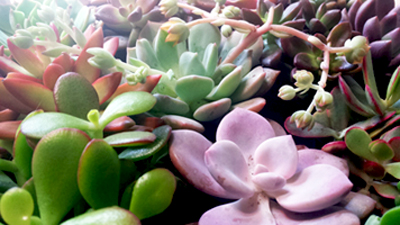

| Living Gifts For Every Occasion | ||
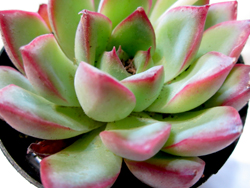 |
Echeveria Pullidonis | |
Echeveria agavoides-Echeveria pulidonis hybrid is a cross that exhibits characteristics of both parents. Very compact rosette with slightly cupped leaves that are glaucous green with rose margins and tips. In habitat, many Echeverias grow on rocky outcroppings at higher altitudes. In this habitat, the water drains quickly away from the roots of the plant, never allowing the plant to remain waterlogged. For this reason, it is essential in cultivation to use a very porous soil, which will allow quick drainage. Bright light is required to prevent "stretching" of Echeverias ("stretching" occurs when a moderately fast growing plant such as an Echeveria, is grown in dim light or over-fertilized, which causes overly lush growth that contributes to weak, pallid plants). Water thoroughly when soil is dry to the touch. Protect from frost. $5.25 |
||
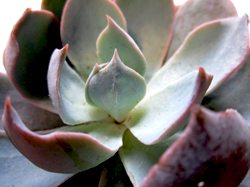 |
Echeveria Subsessillis | |
| Echeveria subsessillis, native to Mexico, forms compact rosettes of flattened, spoon-shaped leaves. Rosettes are sky blue, blushing pink along the margins in strong light. Hummingbirds love arching stems of pinkish-orange bell-shaped flowers. Great windowsill or rock garden plant. Water thoroughly when soil is dry to the touch. Protect from frost.
$5.25 |
||
 |
Echeveria Black Prince |
|
| The genus Echeveria is named after the 18th century Spanish botanist Atanasio Echeverria Codoy. Echeveria 'Black Prince', unusual for an Echeveria in that it is nearly black in color, forms lovely dark star-shaped rosettes. Red bell-shaped flowers contrast lovely dark rosette. Excellent as color accent in dish gardens or rock gardens. Water thoroughly when soil is dry to the touch. Protect from frost.
$5.25 |
||
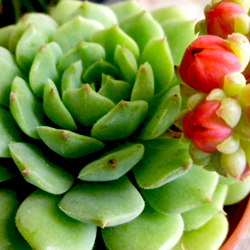 |
Echeveria Dondo | |
| Echeveria 'Dondo' forms a very compact rosette of short, chunky apple green leaves. Very short racemes with multiple floral displays of bright orange bell-shaped flowers that are golden yellow inside and appear to be molded from wax. Water thoroughly when soil is dry to the touch. Protect from frost.
$5.25 |
||
 |
Echeveria Lola | |
| Echeveria 'Lola', possibly a hybrid of Echeveria lilacina, forms a sculpted rosette with a somewhat "rosebud" shape. Leaves are alabaster marble with a delicate blush of pinkish violet and tipped with rose. Rosette gives the impression of alabaster wax suffused with violet. Flowers are peach, bell-shaped and appear in spring. Water thoroughly when soil is dry to the touch. Protect from frost.
$5.25 |
||
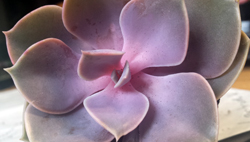 |
Echeveria Perle v Nurnberg | |
| Echeveria 'Perle von Nurnberg', one of the most beautiful of Echeverias, is a hybrid of Echeveria gibbiflora v. metallica and Echeveria potosina. Rosette to 6" in diameter of lovely pruinose violet pink with somewhat triangular leaves. Gracefully arching spike of delicate coral flowers during spring months. Excellent for windowsill culture or as color accent in rock garden or dish garden. Water thoroughly when soil is dry to the touch. Protect from frost.
$5.99 |
||
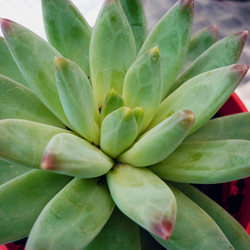 |
Pachyveria Glauca 'Little Jewel' | |
Pachyveria are hybrids between the genera Pachyphytum and Echeveria (most hybrids are between species in the same genus). Pachyveria 'Glauca' (commonly known as "Little Jewel") forms tapered cylindrical leaves of dusky powdery blue with reddish tints at the tips and some violet tones. In late winter, melon-colored flowers appear on arching racemes. Forms very structural spiky rosette that is great for dish gardens and rock gardens both for its unusual color and shape. Porous soil with adequate drainage. Bright light to full sun. Water thoroughly when soil is dry to the touch. Protect from frost. Propagation: Pachyveria can have characteristics of either parent, and some are sterile and can only be propagated vegetatively, not from seed. Growing Tips: Succulent plants require a very quickly draining soil, either with extra drainage material such as sand with all dust and small particles sieved out or one specially developed for cacti and succulent plants. Also beneficial is a mulch of small stones or gravel to assist in drainage around the base of the plant. Water thoroughly only when the soil is quite dry and avoid watering altogether in cooler weather and winter. Use fertilizer sparingly while plants are actively growing. We suggest planting succulent plants in a clay pot, partly for their good drainage, and also to prevent large heavy plants from tipping over while drying out as recommended between waterings. $5.25 |
||
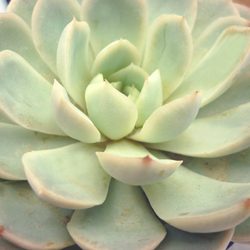 |
Echeveria 'Fleur Blanc' | |
| Echeveria Fleur Blanc, native to Nuevo Leon, Mexico, forms a finely sculpted rosette with geometric perfection. The leaves are somewhat obtuse, wide and are silvery white with a violet tinge. Each leaf is very pruinose (covered with protective white powder) and somewhat upcurved to form very ornate rosette. Apricot bell-shaped flowers are borne on arching racemes in spring. Excellent as patio plant or as color accent in rock garden. Water thoroughly when soil is dry to the touch. Protect from frost.
$5.99 |
||
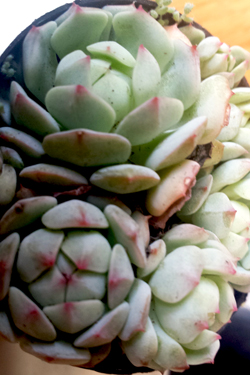 |
Echeveria Derenbergii - 'Painted Lady' | |
| Echeveria derenbergii is native to Oaxaca, Mexico. It forms small rosettes with fleshy, glaucous light silvery blue leaves with pink tips. Freely offsetting to form clusters quickly. It is also known as the "Painted Lady". It forms short arching racemes of golden-yellow flowers with orange tips. Great for windowsill or dish garden culture. Water thoroughly when soil is dry to the touch. Protect from frost.
$5.25 |
||
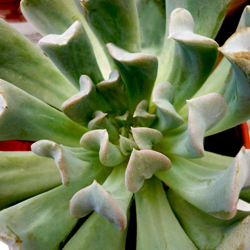 |
Echeveria Runyonii 'Topsy Turvy' | |
| Echeveria 'Topsy Turvy, believed to be a variant of Echeveria runyonii, forms upswept rosettes to 6" or more in diameter. The leaves are tubular with widened tips, and icy silver blue in color. 'Topsy Turvy' is considered by some to be a monstrose form, as the leaves are tubular, whereas the leaves of Echeveria runyonii are somewhat flattened, fleshy and have rounded tips. A very easily grown plant that is excellent for windowsill culture, in the rock garden or as a patio plant. Water thoroughly when soil is dry to the touch. Protect from frost.
$5.25 |
||
 |
Echeveria Ramillette | |
| Echeveria 'Ramillete' is a hybrid Echeveria that forms rosettes of fleshy green leaves with red tips. Profuse racemes of tangerine bell-shaped flowers. Very tips of orange flower are golden, adding a bright, cheery appearance to the floral bouquet. Excellent for dish gardens and in rock gardens.Water thoroughly when soil is dry to the touch. Protect from frost.
$5.25 |
||
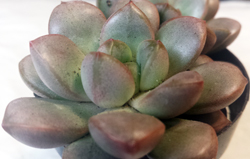 |
Echeveria Aphrodite | |
| Echeveria 'Aphrodite' forms rosettes of very chubby, pale frosty green leaves with some pink tinges and pink tips. The parents used to create this hybrid Echeveria were Echeveria elegans and Echeveria agavoides.Water thoroughly when soil is dry to the touch. Protect from frost.
$5.99 |
||
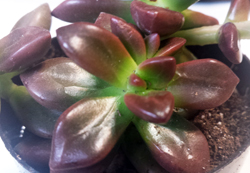 |
Echeveria Compressicaulis | |
| Based on material collected in the Venezuelan state of Mérida, Echeveria compressicaulis (Crassulaceae) is described as a new species. Its stem sculpturing is similar to that of the Mexican E. multicaulis and E. nodulosa, but its exact position in the genus remains enigmatic. Its cultivation and propagation is discussed.
$7.25 |
||
 |
Sedeveria Letizia | |
| According to information on the Sedum Society this is an older hybrid between Sedum cuspidatum X Echeveria setosa var. ciliata that went unnamed until Jean-Michel Moullec published the name in the January 2006 Sedum Society Newsletter (No. 7) honoring his Italian friend Letizia Alleruzzo though it is speculated that the plant likely originated from Fred Wass, a British cactus and succulent collector. Sedum cuspidatum, the seed parent of this plant is a slow growing species from western Chiapas and eastern Oaxaca with red tinged green leaves that rise up on vertical, highly textured stems and with an inflorescence that rises above the foliage with only a few white flowers. The pollen parent, Echeveria setosa var. ciliata (E. ciliata), is a mostly ground hugging plant from Oaxaca with short stems less than 3 inches long, each topped with a flat rosette of many leaves similar in shape to the hybrid that are edged in red with fine hairs. It has red and yellow flowers on an hairy inflorescence that rises well about the foliage. The leaves are green with a red tinge depending on light levels. In full sun, or when stressed, it is almost totally red, in shade the rosettes are totally green. Sedeveria 'Letizia' (Lety's Sedeveria) - is a beautiful small succulent branching at the base with a cluster of stems that grow to about 8 inches tall with 2 1/2 inch wide rosettes bearing many tightly arranged 1 inch long green deltoid shaped leaves with fine hairs along the margins. The older rosettes sit atop slender bare stems while younger ones have leaves the length of the stems. In spring multiple inflorescences rise from below the top of the rosette and, rising above the rosette, bear flowers in a scorpiod cyme that are white with petal tips barely pink with the stem bristling with fine hairs. Plant in full coastal sun to light shade in a well-drained soil and irrigate occasionally. It is hardy to around 21 °F. A great plant for a small choice spot in in the rock or succulent garden and great as a container plant. $7.25 |
||
 |
Echeveria Purpusorum
|
|
| Echeveria purpusorum (usually known as an Urbinia) is one of the slowest-growing Echeverias and it is necessary to cultivate it for many years to get a nice specimen. Its attractiveness lies in the beautifully speckled leaves. It can tolerate sun to shade but the more light a plant gets the better it will display its colours and shape. However, when moving plants from lower light conditions into full sun, be wary of sun scorch, most easily avoided by ensuring plants are well-watered before moving them on a cloudy day. They can tolerate extended dry periods and survive drought without the need for watering, but they will grow stronger if they receive adequate moisture during their growing season, never allowing the plant to remain waterlogged (root rot sensitive). Use a very porous soil, which will allow quick drainage. Slow release fertilisers with a low to moderate nitrogen content are adequate for the spring and summer growing seasons. Good air movement is important for minimizing pest and disease risks, and avoiding excessive humidity. It can tolerate light frosts, but it is best overwintered at 5-10 °C. With the cooler autumn temperatures tending to make their foliage colours become more intense than those of the active summer growing season. $7.25 |
||
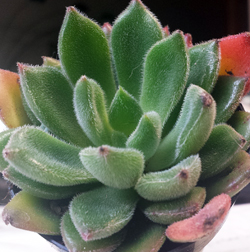 |
Echeveria Santa
|
|
| Possibly a hybrid of 'Doris Taylor'
and Echeveria Setosa, "the Mexican fire cracker", this fuzzy beauty sports yellow, green and bright red festive coloring when temperatures dip slightly.
A great (and hard to find) addition to your container or rock garden.
$7.25 |
||
 |
Echeveria Green Goddess
|
|
| Echeveria 'Haageana' 'Green Goddess' is considered to be a hybrid of Echeveria agavoides & Echeveria harmsii. Forms rosette with broad, fleshy light green pointed leaves that blush pinkish in strong light. Larger inflorescences with orange bell-shaped flowers in late winter and spring attract hummingbirds. Water thoroughly when soil is dry to the touch. Protect from frost.
$5.25 |
||
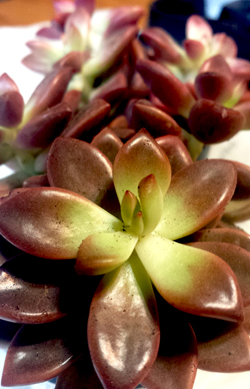 |
Graptosedum 'Vera Higgins'
|
|
| Graptosedum 'Vera Higgins' - A small succulent with reddish-bronze-colored foliage. The 1 inch long leaves, flat on the upper surface and keeled below, whorl around the stem with leaves at the tip arranged in a rosette. The leaves remain somewhat persistent on the stem so that the rosette is usually subtended by several inches of older leaves. In spring appear the terminal clusters of pinkish flower buds that open to reveal the 4-petaled yellow flowers. Growing to about 6 inches tall, it can spread or drape over a pot. Plant in sun (coastal) to light shade with good drainage in areas that don't see severe frosts - has tolerated 25° F without damage and likely can go a bit lower. For several years sold it as Sedum 'Coffee'. It is actually an intergeneric hybrid between Graptopetalum paraguayensis and Sedum stahlii and the correct name should be X Graptosedum 'Vera Higgins' or perhaps 'Bronze' - these two names seem interchangeable and there has been some debate on which is correct. In Holland this plant has been called Graptopetalum Roseum. Some list this as a synonym for Graptoveria 'Alpenglow' but these are distinctly different plants. The Huntington Botanic Garden notes on their information on 'Vera Higgins' that it is more robust and paler than 'Alpenglow'. Our thanks to John Trager of the Huntington Gardens for clearing up our confusion on the name of this little beauty. The name honors Vera Higgins (1892-1968), a British botanical artist, author, translator and fellow of the Linnean Society of London and recipient of the Royal Horticultural Society Victoria Medal of Honour in 1946. She was the the first editor of The Cactus Journal of the Cactus & Succulent Society of Great Britain from 1931 thru 1939 when World War II forced the Society to close down. During the war she was the editor of the Journal of the Royal Horticultural Society. Her last book was Crassulas in Cultivation, written in 1964.
$7.25 |
||
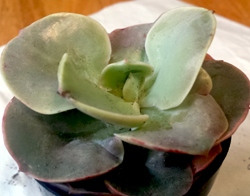 |
Echeveria Nova
|
|
| This is a new hybrid of Echeveria Cass and Echeveria Perle v Nurnberg. Extremely limited availability.
$6.25 |
||
 |
Graptoveria Bella
|
|
| Graptoveria 'Bella' is a hybrid of unknown lineage. Forms rosettes that become somewhat bushy with very chubby glaucous blue-green leaves with pointed tips. In bright light, leaves are very dusky purple. Very unusual color contrast.
$5.25 |
||
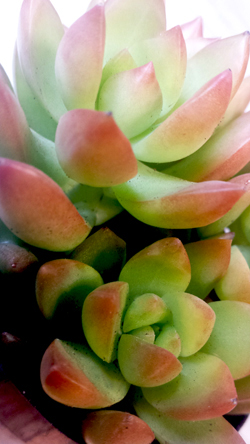 |
Sedum Golden Glow
|
|
| Sometimes confused with Sedum nussbaumerianum, this trailing succulent has tawny gold fleshy leaves spiraling around traling stems. 6-8" tall with a spread of 15-20". Great in succulent planters, or use as a drought tolerant ground cover in warm climates.
$5.95 |
||
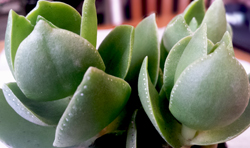 |
Crassula Lactea
|
|
| Crassula lactea known as Taylor's Parches is a perennial flowering plant native to southern Africa. It blooms in the winter with white flowers.
Hardly every available. Extremely limited availability.
$7.95 |
||